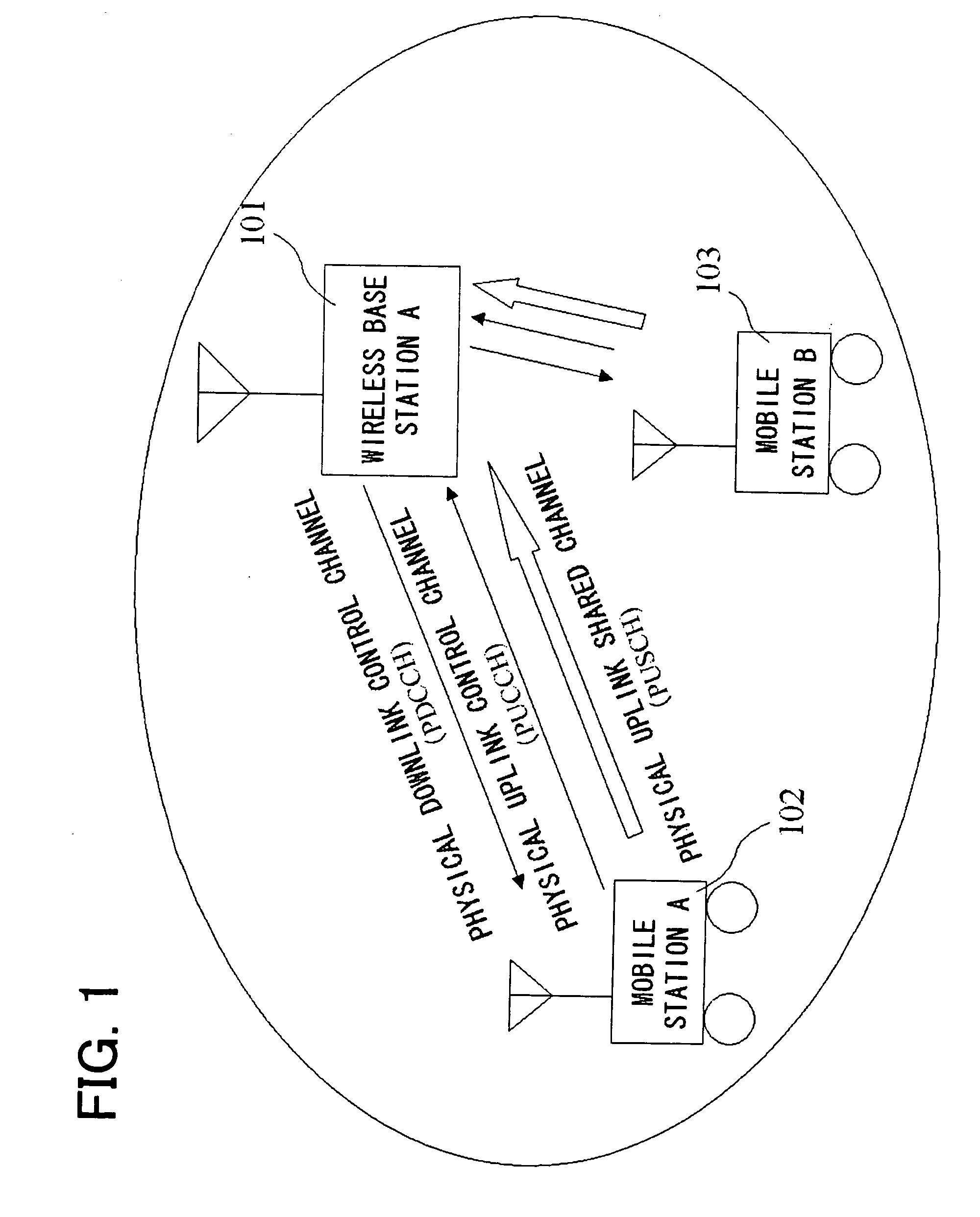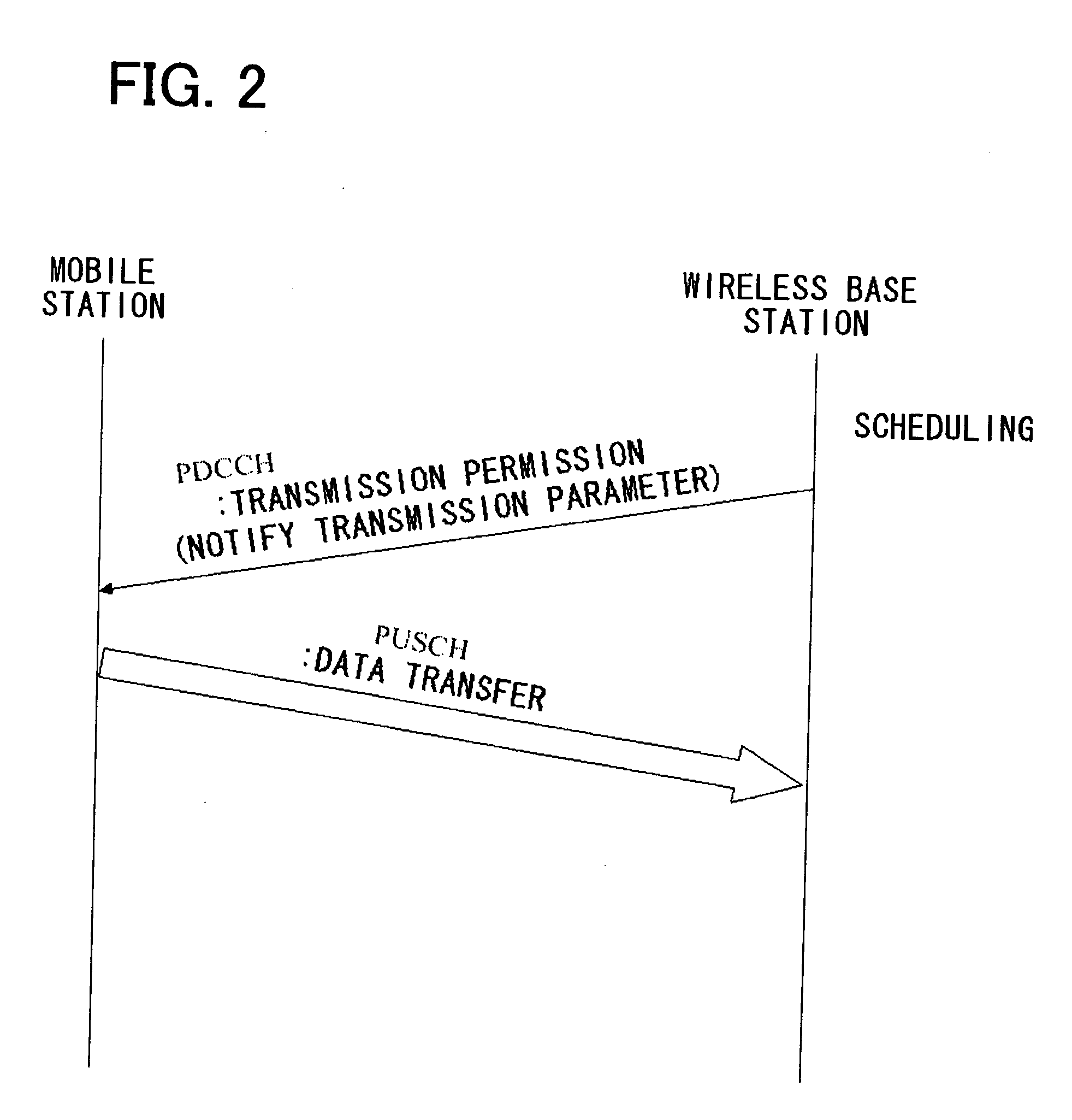Wireless communication system, data transmission method for uplink thereof, base station device, and mobile station device
- Summary
- Abstract
- Description
- Claims
- Application Information
AI Technical Summary
Benefits of technology
Problems solved by technology
Method used
Image
Examples
first exemplary embodiment
[0041]In a first exemplary embodiment of the present invention, the wireless base station sends the transmission parameter that includes the following: modulation method (Mod_tx) such as BPSK, QPSK, 16QAM, etc., bandwidth (N_tx), PUSCH transmission power value (P_tx) from the mobile station to the wireless base station, and the coding rates of the data signal and the control signal.
[0042]This exemplary embodiment is based on the premise that the wireless base station knows the power value (P_UE_Ref) of the reference signal for measuring the quality of the wireless uplink link via which the mobile station sends signals. It is also assumed that the wireless base station can determine the modulation method (Mod_tx) to be assigned and the bandwidth (N_tx) based on the measured reception quality.
[0043]First, the wireless base station calculates the data signal coding rate (Rdat) that satisfies BLER (BLER_target_dat) required for the data signal based on the measured reception quality and...
second exemplary embodiment
[0055]Next, the following describes a second exemplary embodiment in which the wireless base station sends the transmission parameters that include the data signal size (DBS) before coding and rate matching processing, instead of the data signal coding rate and the control signal coding rate, for reducing the overhead of the transmission parameters.
[0056]This exemplary embodiment makes use of the fact that the information amount of the control signal is very much smaller than that of the data signal and, so, the temporary coding rate (DBS / TxBS), calculated from the data signal size (DBS) before coding and rate matching processing and the transmission data size (TxBS), can be approximated to the actual data signal coding rate (DBS / CDBS), that is, (DBS / TxBS≈DBS / CDBS).
[0057]If each of the wireless base station and the mobile station finds a unique control signal coding rate (Rctrl) based on the temporary coding rate (DBS / TxBS) described above, the necessary transmission parameters can ...
third exemplary embodiment
[0062]Next, the following describes a third exemplary embodiment of the present invention in which the change made by the second exemplary embodiment is applied and, in addition, a different coding rate is applicable to each control signal.
[0063]FIG. 5 shows an example of a table used to find the coding rate (Rctrl_m) of each control signal m based on the temporary coding rate (DBS / TxBS) that is calculated from the data signal size (DBS) before coding and rate matching and the transmission data size (TxBS). That is, the table equivalent to the one shown in FIG. 4 is prepared for each of the control signals, such as Ack / Nack, CQI, and MIMO parameters, and the coding rate Rctrl_m_x that satisfies the BLER required for each control signal is set in the table.
[0064]The total sum (CCBS) of the control signals after coding processing is calculated as follows. CCBS=Σ(CCBS_m)=Σ(CBS™ / Rctrl_m) (where, m=1-N: N is the total number of independent control signals).
[0065]The method for determinin...
PUM
 Login to View More
Login to View More Abstract
Description
Claims
Application Information
 Login to View More
Login to View More - R&D
- Intellectual Property
- Life Sciences
- Materials
- Tech Scout
- Unparalleled Data Quality
- Higher Quality Content
- 60% Fewer Hallucinations
Browse by: Latest US Patents, China's latest patents, Technical Efficacy Thesaurus, Application Domain, Technology Topic, Popular Technical Reports.
© 2025 PatSnap. All rights reserved.Legal|Privacy policy|Modern Slavery Act Transparency Statement|Sitemap|About US| Contact US: help@patsnap.com



